| Part of a series on the |
| Culture of Puerto Rico |
|---|
 |
| Society |
| Topics |
| Symbols |

Puerto Rican cuisine consists of the cooking style and traditional dishes original to Puerto Rico. It has been primarily influenced by the ancestors of the Puerto Rican people: the indigenous Taínos, Spanish colonizers, and sub-Saharan African slaves. As a territory of the United States, the culinary scene of Puerto Rico has also been moderately influenced by American cuisine.[4]
History

Puerto Rican cuisine is a product of diverse cultural influences, including Taíno Arawak, Spanish Criollos, and Africans.[5] It is characterized by a unique blend of Spanish seasonings and ingredients, which makes it similar to Spanish and other Latin American cuisines.[6][7] Locally, it is known as cocina criolla.[8][9]
The roots of traditional Puerto Rican cuisine can be traced back to the 15th century. In 1848, the first restaurant, La Mallorquina, was opened in Old San Juan.[10] The island's first cookbook, El Cocinero Puerto-Riqueño o Formulario, was published in 1859.[11]
Taíno influence
%252C_en_Ponce%252C_Puerto_Rico_(DSC02261).jpg.webp)
See: Indigenous cuisine of the Americas
Many of the arrowroots and root vegetables used in Puerto Rican cuisine, collectively known as viandas, have their roots in the diets of the indigenous Taíno people.[12][13] These include cassava (Spanish: yuca) and three kinds of tannier (Spanish: yautía)[14] which are staples in traditional Puerto Rican dishes.[15] Other popular root vegetables include sweet corn root (Spanish: lerén), sweet potato (Spanish: batata mameya), arracacia xanthorrhiza (Spanish: apio criollo), white sweet potato (Spanish: batata) this potato has a purple flesh but white inside and yambee (Spanish: yambi), all of which are cultivated in the mountain regions of the island.[16]
It is hypothesized that Taínos used cooking methods that resemble what is called barbecue today. By some counts, the earliest recorded use of the term barbecue can be traced back to a journal entry made by a Spanish settler upon landing in the Caribbean.[17] The term was used by the indigenous Taino people, who referred to the practice of slow-cooking food over a raised wooden platform as barabicu, which means "sacred pit" in their language.[18] While the Tainos likely slow-roasted fish due to the region and their diet at the time, this cooking method may have given rise to what we know today as barbecue.[17]
Spanish/European influence

See: Spanish cuisine
- Arroz con dulce – In Puerto Rico rice pudding is made with rice, sugar, coconut milk, milk, clove, cinnamon, ginger, star anise, rum, and raisins. Some variations include added purees such as squash, sweet plantains, batata, yuca, and ripe breadfruit. Cream cheese and pistachios are popular and a rice pudding made with additional egg, lemon peel, and cream cooked just like crème brûlée. The first written record known to exist about this dish dates 1859 but historians can trace it as far back as the 16th century.[19]
- Flan – A milk and caramel custard very popular throughout Puerto Rico. There are several ways to make this dish. Some are unique to Puerto Rico, such as breadfruit and sesame seeds. Coconut[20] and pumpkin[21] are two popular varieties.
African influence
See: African cuisine
Coconuts, coffee (brought by the Arabs and Corsos to Yauco from Kafa, Ethiopia), okra, taro (malanga), tamarind, yams (ñame), sesame seeds, gandules (pigeon peas), plantains, many varieties of bananas, other root vegetables and Guinea hen, all came to Puerto Rico from, or at least through, Africa. African slaves also introduced the deep-frying of food, such as cuchifritos.[22]
Regional
Arecibo
Arecibo is the biggest municipality in Puerto Rico by area and is located on the northern coast. In the Río Grande de Arecibo, whitebait called cetí is caught.[23]
Basic ingredients
Seafood and shellfish

On some coastal towns of the island, such as Luquillo, Fajardo, and Cabo Rojo, seafood is quite popular.
Seasoning blends
Traditional cooking on the island uses more fresh and local ingredients such as citrus to make mojo and mojito isleño and especially fresh herbs, vegetables and peppers to make recaíto and sofrito.[26]
The base of many Puerto Rican main dishes involves sofrito, similar to the mirepoix of French cooking, or the "trinity" of Creole cooking. A proper sofrito is a sauté of freshly ground garlic, tomatoes, onions, recao/culantro, cilantro, red peppers, cachucha and cubanelle peppers. Sofrito is traditionally cooked with olive oil or annatto oil, tocino (bacon), salted pork and cured ham. A mix of stuffed olives and capers called alcaparrado are usually added with spices such as bay leaf, sazón and adobo.[27]
Puerto Rican dishes

Although Puerto Rican diets can vary greatly from day to day, there are some markedly similar patterns to daily meals. Dinners almost invariably include a meat, and rice and beans.[5]
.jpg.webp)
Codfish and taro is also a popular dish.
Thanksgiving dishes
- Dulce – The fusion of American mainland and Puerto Rican food can be clearly seen in Thanksgiving desserts. Puerto Rican desserts use the same traditional ingredients as American holiday desserts including pumpkin, yams, and sweet potatoes. Classic sweets are infused with sweet viandas. Flan de calabasas (squash flan), Tortitas de Calabaza (pumpkin tarts), Cazuela (a pie made with pumpkin, sweet potato, coconut, and sometimes carrots), Barriguitas de Vieja (deep-fried sweet pumpkin fritters made with coconut milk and spices), Cheese cake with tropical fruit, Buñuelos de Calabasas o platáno (pumpkin or sweet plantains doughnuts), and Budín de Pan y calabasas (bread pudding made from squash bread).[28]
Christmas dishes

Puerto Rican culture can be seen and felt all year-round, but it is on its greatest display during Christmas when people celebrate the traditional aguinaldo and parrandas – Puerto Rico's version of carol singing. Puerto Rican food is a main part of this celebration.
- Pasteles – For many Puerto Rican families, the quintessential holiday season dish is pasteles, a soft dough-like mass wrapped in a banana or plantain leaf and boiled, and in the center chopped meat, shellfish, chicken, raisins, spices, capers, olives, sofrito, and often garbanzo beans. Puerto Rican pasteles are made from either green bananas or starchy tropical roots. The wrapper in a Puerto Rican pastel is a banana leaf.[29]
- Tembleque – Sweets are common in Puerto Rican cuisine. During the holidays, one dessert is tembleque, a coconut-based dessert pudding.[30]
Beverages
_from_Ponce%252C_Puerto_Rico_(IMG_3046).jpg.webp)
- Chocolate caliente – hot chocolate made with cocoa, vanilla, milk, and spices and topped with whipped cream.[31]
Kiosks
Rustic stalls displaying many kinds fritters under heat lamps or behind a glass pane can be spotted in many places throughout Puerto Rico. Collectively known as frituras, these snacks are called cuchifritos in New York City, but to be strictly correct, cuchifritos are the mom-and-pop stores where frituras are sold. In Puerto Rico, the name quiscos (kiosk) is used to refer to the cuchifrito.[32][33] Quioscos are a much-frequented, time-honored, and integral part to a day at the beach and the culinary culture of the island. Fresh octopus and conch salad are frequently seen. Much larger kiosks serve hamburgers, local/Caribbean fusion, Thai, Italian, Mexican and even Peruvian food. Most kiosks have a signature alcoholic drink.
- Bacalaítos – Bacalaítos are codfish fritters that are served at many kiosks.[34]
- Sorullos – The cornmeal equivalent of mozzarella sticks, except fatter and shorter. They are often made with cheese.
Puerto Rican food outside Puerto Rico


- Cuchifritos – In New York, cuchifritos are quite popular. Cuchifritos, often known as "Puerto Rican soul food" includes a variety of dishes, including, but not limited to: morcilla (blood sausage), chicharron (fried pork skin), patitas (pork feet), masitas (fried porkmeat), and various other parts of the pig prepared in different ways.
- Jibarito (plaintain sandwich) – In Chicago, el jibarito is a popular dish.[35] The word jíbaro in Puerto Rico means a man from the countryside, especially a small landowner or humble farmer from far up in the mountains. Typically served with Puerto Rican yellow rice, jibaritos consist of a meat along with mayonnaise, cheese, lettuce, tomatoes and onions, all sandwiched between a fried plantain, known as a canoa (canoe). In the early 20th century, bread made from wheat (which would have to be imported) was expensive out in the mountain towns of the Cordillera Central, and jíbaros were made from plantains which are still grown there on the steep hillsides. The version introduced to Chicago was originally made with skirt steak, but today it can be found in versions made with chicken, roast pork, ham, shrimp and even tofu.[36]
Chefs
- Doreen Colondres - chef, television presenter, food writer and sommelier
- Luis Antonio Cosme – Puerto Rican actor and television chef
- Giovanna Huyke – television chef
- Daisy Martinez – cookbook author and host of Daisy Cooks! on PBS and ¡Viva Daisy! on the food network
Gallery
 Table with typical sweets in Húcares, Naguabo
Table with typical sweets in Húcares, Naguabo Rotisserie chicken, twice-fried plantain in Ciales, Puerto Rico
Rotisserie chicken, twice-fried plantain in Ciales, Puerto Rico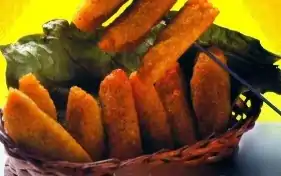 Alcapurrias
Alcapurrias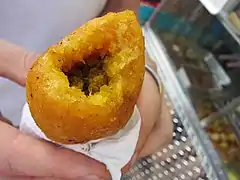 Papa rellena de Puerto Rico
Papa rellena de Puerto Rico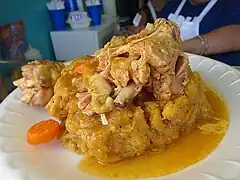 Mofongo, prepared in New York
Mofongo, prepared in New York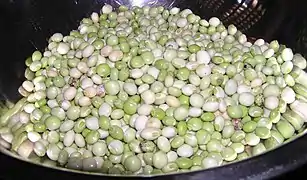 pigeon peas (gandules)
pigeon peas (gandules) Yuca, Puerto Rican name for cassava
Yuca, Puerto Rican name for cassava
 Acerola cherry
Acerola cherry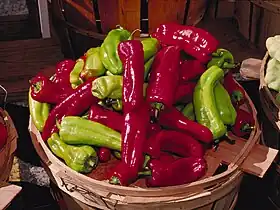 Green and red cubanelle peppers are used to make sofríto
Green and red cubanelle peppers are used to make sofríto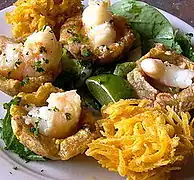 Plantain "arañitas" and "tostones rellenos"
Plantain "arañitas" and "tostones rellenos"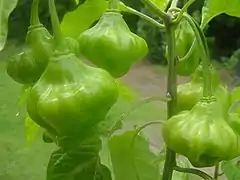 Ajicitos / Cachucha, a.k.a., Ají Dulce, the Habanero chili pepper's mild cousin
Ajicitos / Cachucha, a.k.a., Ají Dulce, the Habanero chili pepper's mild cousin Ajíes caballero (aka, Puerto Rican Jelly Bean Hot Chili Pepper) is a very hot local pepper
Ajíes caballero (aka, Puerto Rican Jelly Bean Hot Chili Pepper) is a very hot local pepper.JPG.webp) Marinated cassava (Spanish: Yuca en escabeche)
Marinated cassava (Spanish: Yuca en escabeche)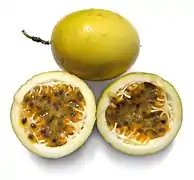 Parcha, passion fruit, is often made into passion fruit juice
Parcha, passion fruit, is often made into passion fruit juice Coconut with straw at restaurant in Esperanza, Vieques
Coconut with straw at restaurant in Esperanza, Vieques Pique (Puerto Rican Hot Sauce)
Pique (Puerto Rican Hot Sauce)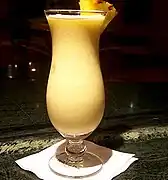 Piña Colada
Piña Colada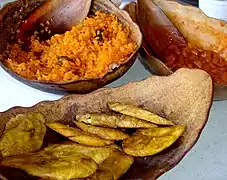 Puerto Rican cooking has a unique blend of influences.
Puerto Rican cooking has a unique blend of influences. Grilled yellow snapper with green papaya salad and tostones
Grilled yellow snapper with green papaya salad and tostones
See also
References
- ↑ Reporter's Notebook. York Daily Record (York, Pennsylvania). 15 December 2003. Page 35. Accessed 24 January 2021.
- ↑ El Gusto Boricua en el Sur de la Florida. Yined Ramírez-Hendrix. El Nuevo Herald (Miami, Florida). 27 July 2011. Page D12. Accessed 24 January 2021.
- ↑ Sofrito, imprescindible para latinos. Viviana Caraballo. El Nuevo Herald (Miami, Florida). 6 January 1999. p. 19. Accessed 24 January 2021.
- ↑ Proctor, Tammy (November 28, 2022). "Eating the Past: The rich history of Puerto Rican food". UPR. Archived from the original on January 28, 2023. Retrieved April 27, 2023.
- 1 2 Albala, Ken (2011). Food Cultures of the World Encyclopedia. Greenwood. p. 656 – via Temple University.
- ↑ "Herencia de los taínos". EnciclopediaPR. Retrieved April 27, 2023.
- ↑ Diaz, Von (March 22, 2021). "Von Diaz's Essential Puerto Rican Recipes". The New York Times. ISSN 0362-4331. Retrieved April 27, 2023.
- ↑ "What Are Puerto Rican Food Staples?". The Spruce Eats. Retrieved April 27, 2023.
- ↑ Torres-González, Joseph A. (2021). "Review of De los plátanos de Oller a los Food Trucks: Comida, alimentación y cocina puertorriqueña en ensayos y recetas". Caribbean Studies. 49 (2): 184–186. ISSN 0008-6533. JSTOR 48669805.
- ↑ Porter, Darwin; Prince, Danforth (June 25, 2007). Frommer's Portable Puerto Rico. Wiley. ISBN 9780470100523.
- ↑ Ortiz, Yvonne. A Taste of Puerto Rico: Traditional and New Dishes from the Puerto Rican Community. Penguin group, 1997. P. 3
- ↑ "Taino | History & Culture | Britannica". www.britannica.com. Retrieved April 28, 2023.
- ↑ Ortiz Cuadra, Cruz (September 16, 2011). "Las viandas: esa entrañable relación con la comida de las madres". 80 grados. Retrieved April 27, 2023.
- ↑ Barrett, Otis Warren (1905). The Yautias, Or Taniers, of Porto Rico. Porto Rico Agricultural Experiment Station.
- ↑ Magazine, Smithsonian. "What Became of the Taíno?". Smithsonian Magazine. Retrieved April 28, 2023.
- ↑ Raíces y Tubérculos. Centro de Recursos Informativos Digitales Agrícolas de Puerto Rico (CRIDAg). University de Puerto Rico en Mayaguez. 2018. Accessed 8 December 2018.
- 1 2 M, K. "The History of Barbecuing". The Food Network. Retrieved April 27, 2023.
- ↑ "Tienen historia: ¿BBQ o barbacoa?". Primera Hora (in Spanish). October 24, 2016. Retrieved April 28, 2023.
- ↑ Arroz con dulce: ese histórico obsequio de Reyes. Cruz Miguel Ortiz Cuadra, PhD. 80 Grados: Prensa sin Prisa. 3 January 2012. Accessed 15 January 2022. Archived.
- ↑ Flan de coco. Zulma Santiago. Welcome to Puerto Rico. Accessed 25 July 2022. Archived.
- ↑ Flan de Calabaza. Cielito Rosado. Bordens de Puerto Rico. undated. Accessed 25 January 2022. Archived.
- ↑ "A slice of Puerto Rican history". The Salt Lake Tribune.
- ↑ "Historia del Cetí en Puerto Rico y el Caribe". foodiespr.com (in Spanish). February 3, 2015. Retrieved August 25, 2019.
- ↑ Historia del Cetí en Puerto Rico y el Caribe. Ferdinand Quiñones. FoodiesPR.com February 2015. Accessed 25 January 2022. Archived.
- ↑ Nos gusta el bacalao, pero el chillo es el rey de la mesa puertorriqueña Según varios expertos, el chillo es el pescado favorito de los consumidores del país. Agustín Criollo Oquero. Primera Hora. 12 August 2014. Accessed 25 January 2022. Archive.
- ↑ "The ultimate Puerto Rican food guide". Explore Parts Unknown. October 1, 2017. Retrieved August 25, 2019.
- ↑ Taylor, David (June 5, 2020). "Legendary Puerto Rican Cookbook Cocina Criolla begins with many details & Sofrito!". Hispanic Food Network. Retrieved June 22, 2020.
- ↑ Ortiz Cuadra, Cruz Miguel (2013). Eating Puerto Rico: A History of Food, Culture, and Identity. Latin America in Translation/en Traducción/em Tradução. University of North Carolina Press. p. 82. ISBN 978-1-4696-0882-2. Retrieved October 12, 2019.
- ↑ Receta para preparar los tradicionales pasteles puertorriqueños de navidad. Daysla Cancel. La Opinion. 24 December 2018. Archived.
- ↑ Five Favorite Puerto Rican Holiday Recipes: Tembleque. Discover Puerto Rico. Accessed 6 February 2022. Archived.
- ↑ Halpern, Ashlea (April 30, 2014). "18 Things to Eat, Buy and Do in Puerto Rico - Casa Cortés ChocoBar". Bon Appetit. Condé Nast.
- ↑ Frituras. Recetas Boricuas. Accessed 25 January 2022. Archived.
- ↑ Las frituras son nuestro manjar-VÍDEO: Un sondeo informal por el área de Piñones demostró que la alcapurria es la gran favorita. Istra Pacheco. Primera Hora. 26 July 2013. Accessed 25 January 2022. Archived.
- ↑ Ortiz, Y. A Taste of Puerto Rico: Traditional and New Dishes from the Puerto Rican Community. Plume, publishers. The William G. Lockwood and Yvonne R. Lockwood Collection of National, Ethnic and Regional Foodways. 1997. ISBN 9780525938125
- ↑ "Jibarito Sandwich: What You Need To Know". Retrieved April 28, 2016.
- ↑ Bizzari, Amy (2016). Iconic Chicago Dishes, Drinks and Desserts. Arcadia. pp. 46–53. ISBN 9781467135511.
External links
- El Boricua - Puerto Rican traditional recipes
- Carmen Santiago, Puerto Rican chef Archived November 11, 2019, at the Wayback Machine